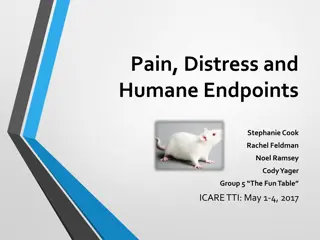Understanding and Minimizing Pain and Distress in Research Protocols
This content explores the importance of reviewing research protocols to minimize pain and distress in animal experiments. It covers defining pain, distress, experimental and humane endpoints, evaluating management strategies, and ensuring ethical practices. It also includes a quick exercise to assess the level of pain and distress in various research procedures based on guidelines and definitions. The module emphasizes the need for researchers to uphold humane endpoints and consider animal welfare in their studies.
Download Presentation

Please find below an Image/Link to download the presentation.
The content on the website is provided AS IS for your information and personal use only. It may not be sold, licensed, or shared on other websites without obtaining consent from the author. Download presentation by click this link. If you encounter any issues during the download, it is possible that the publisher has removed the file from their server.
E N D
Presentation Transcript
Pain & Pain & Distress / Humane Distress / Humane Endpoints Endpoints Alice Huang, Kiirsa Pokryfke, Ernie Prentice, Stacy Pritt, William Singleton
Goal Understand how to effectively review protocols to ensure pain & distress are minimized consistent with sound research design
Objectives 1. Define pain, distress, experimental endpoints, and humane endpoints 2. Evaluate the potential for pain and distress 3. Determine the acceptability of the management of possible pain and distress 4. Ensure an appropriate link between experimental and humane end points
Painful, Distressful, Neither, or Both? (2 Mins) Assign the best descriptor for each procedure listed below: 1) Bone marrow depletion via irradiation in a mouse 2) Head cap placement surgery in a song bird 3) Laparotomy in a rabbit 4) MRI imaging of a pig while it is anesthetized 5) Singly housed NHP 6) Study design which includes mice in cages and cats walking around the room 7) Treadmill running stimulus via foot shock for a mouse
Definitions from the Standards USDA AC Policy #11: A painful procedure is defined as any procedure that would reasonably be expected to cause more than slight or momentary pain or distress in a human being to which that procedure is applied, that is, pain in excess of that caused by injections or minor procedures. Guide pg. 121: Distress may be defined as an aversive state in which an animal fails to cope or adjust to various stressors with which it is presented. But distress may not induce an immediate or observable pathologic or behavioral alteration, making it difficult to monitor and evaluate the animal s state when it is present.
Review & Revise? (5 Mins) USDA AC Policy #11: A painful procedure is defined as any procedure that would reasonably be expected to cause more than slight or momentary pain or distress in a human being to which that procedure is applied, that is, pain in excess of that caused by injections or minor procedures 1) Bone marrow depletion via irradiation in a mouse 2) Head cap placement surgery in a song bird 3) Laparotomy in a rabbit 4) MRI imaging of a pig while it is anesthetized 5) Singly housed NHP 6) Study design which includes mice in cages and cats walking around the room 7) Treadmill running stimulus via foot shock for a mouse Guide pg. 121: Distress may be defined as an aversive state in which an animal fails to cope or adjust to various stressors with which it is presented. But distress may not induce an immediate or observable pathologic or behavioral alteration, making it difficult to monitor and evaluate the animal s state when it is present.
Humane & Experimental Endpoints Experimental endpoints are those outcomes needed to achieve research goals. Specific criteria that will allow recognition of when the experimental outcomes have been met should be identified. Humane endpoints are defined criteria and interventions which are used instead of more severe experimental outcomes such as advanced clinical disease or death. Using humane endpoints allows scientists to minimize pain and distress while carrying out studies to understand and develop treatments for diseases. Adapted from the 3Rs Centre Utrecht Life Sciences and the Guide
A systematic Approach for Establishing Humane Endpoints A systematic Approach for Establishing Humane Endpoints Example Humane Endpoint: An animal must be euthanized once it has been observed to not be eating or drinking for greater than 24 hours Morton, D. 2000 ILAR Journal Volume 41 Issue 2 Pages 83-86
Evaluate a Pain & Distress Management Plan (5 Mins) Chronic Heart Failure Model in a hamster subsequent to coronary artery ligation performed via a thoracotomy Formulate two questions/group: Group 1) Pre-operative measures Group 2) Intraoperative measures Group 3) Post-operative measures Group 4) Veterinary Support Group 5) Humane endpoints for this model
Objectives Review 1. Define pain, distress, experimental, and humane endpoints 2. Evaluate the potential for pain and distress 3. Determine the acceptability of the management of possible pain and distress 4. Ensure an appropriate link between experimental and humane end points
Summative Assessment Mock IACUC Meeting On an individual basis, each trainee will identify the problems, deficiencies, and concerns in the scenario and document their findings (the documentation will eventually be given to the facilitator). In a mock IACUC meeting, each individual will be asked to identify and present one of their findings. The individual should articulate the significance of the identified issue. After all of the trainees have presented one issue, the facilitator will open up the protocol scenario for further discussion about other issues not previously identified. The facilitator will be provided a list (key) of concerns, issues, and deficiencies as identified by experts that can be used to assess the trainee s comprehension.























